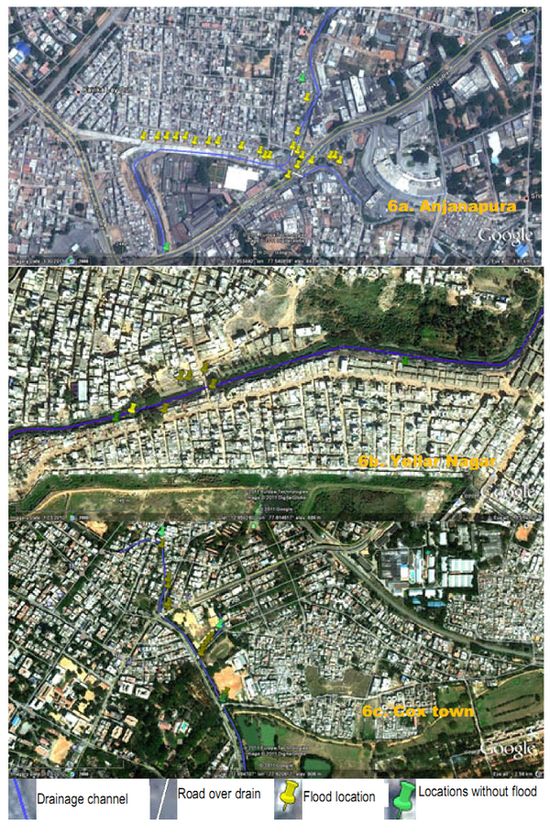|
Results and discussion
Fig 3 shows the drainage path along which the sewers flow out of the city. This image was generated with the help of DEM, which ensure the real existing catchment boundary of the city. Table 1 and Figures 1 give details about sewage flow pattern observed in the surveys. Among the study locations 37 was slow flowing, 47 were moderate flow and only 9 locations had rapid flow patterns. The slow and moderate flow streams observed were all encroached upon and were substantially silted and observably littered with solid wastes (Figure 4). Presence of waste in drainage channels is very common in all slow to very fast drainage channels, almost at 95% locations waste was present. Generally large number of locations had plastics and clothes that clogged the flow path or the channels under the various bridges. However at a few places Styrofoam, building debris and organic wastes along with plastic and cloth were also observed to choke the flow path (Figure 4-5).

Fig 4: Drains littered with solid waste. Picture on left shows clear signs of flooding

Fig 5: Solid wastes in storm water drains which can choke the water flow under peak conditions.
The presence of undecomposed organic wastes showed firstly the origin (namely house holds, hotels or commercial establishments) and second that this heap was of recent origin. The presence of unfermented food and leaf wastes indicates that these decomposable materials did not have adequate time to degrade and therefore is of recent origin. From observing a few marker species, cabbage, onion, potato etc. we could determine the age of wastes and by various toys as to where these originated China, etc. Most of the fresh wastes were observed only on the banks of the streams and not actually in the stream. As much of the components of domestic wastes is of food origin in Bangalore, it is expected that all fermentables suffer a rapid degradation and become indistinguishable in a very short time. Typically, organic waste takes around 5-30 days to degrade. Therefore ultimately only non biodegradable materials like plastic and clothes are left undecomposed in the stream. Usually, construction waste or debris settle in drainage channel and decrease the depth of the drainage network. When present in large quantities it gets accumulated near the edge of the channels and making the flow path narrow. Generally, the habit of many residents who throw garbage in channel has made the stream slow and narrow. All these prevent the free flow of water (Oriola, 1994). Most people who use the sewer as a USW disposal location generally believe that these wastes will flow away with water without causing any harm downstream. In urban area drainage encroachment starts with disposal of construction waste near the edge of these drains or water body. Initially it will be temporary later on with its continuous disposal will cause permanent encroachment of channel or water body. Presently, with the scarcity of land area or due to lack of proper waste management, waste disposal near drains has become a very common phenomenon in urban city.
Urban flooding has become an annual event in Bangalore city. The city has quasi centralized collection system with 75-90% of waste collection efficiency, which is satisfactory and make the city clean (Chanakya et al., 2009). Yet when drains pass by slum areas, a lot of USW is disposed in or around these drains. This suggests that the USW collection system is either absent, inaccessible or inconvenient to these users. This prompts them to throw their USW into the storm water channels /sewers nearby. Similarly, many commercial places also have an inadequate daily collection system and a lot of commercial wastes end up near these drainage channels /sewers. The composition of commercial waste is different from household waste and is characterized by a high content of plastics and paper and a lower content of fermentable matter (Chanakya and Sharatchandra, 2005). To avoid such wastes entering drains it requires providing very efficient collection system in such sensitive areas compared to the rest of the city.
Table 2 and Figure 2 give detailed views about the three main flooding areas studied (near Anjanapura Temple, Yellar Nagar near National Games Village (NGV) and near Cox Town; 2a,b&c respectively). All the three areas have a problem of annual flooding. Near NGV heaps of wastes were observed in this slum. This suggested that the waste collection system was not efficient and regular. It was found from interviews that all the three study locations flooded after 4h of continuous rainfall. All three locations had USW disposed off on their banks firstly reducing the width of the channel and secondly permitting a lot of USW to fall into the sewer and obstruct immediate flow and third provide a very large mass of USW to be carried along during storm flow and choke the channel under the road bridge and thereby causing floods as well as to spread the USW in the flooded area. Fig 6 presents details about locations at which observations were recorded at the three study locations.

Fig 6: Details about three main flood areas taken up for study
|




